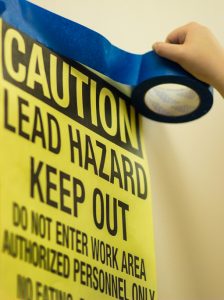 If your home was built around or before 1978, you may have an issue. Homes built before 1978 used lead paint, and the Environmental Protection Agency (EPA) has issued a warning for all homeowners with homes built around this time. Lead paint presents a number of dangers to living organisms, especially you, your family, and your pets.
If your home was built around or before 1978, you may have an issue. Homes built before 1978 used lead paint, and the Environmental Protection Agency (EPA) has issued a warning for all homeowners with homes built around this time. Lead paint presents a number of dangers to living organisms, especially you, your family, and your pets.
Deteriorating lead paint is especially dangerous for young children, and you might not even notice it. The deteriorating paint forms dust, and then children and adults inhale that dust. It is invisible and unlikely to be seen, so if you have not dealt with the lead paint in your home, you could already be dealing with the health complications.
What next?
First, determine if you actually have lead paint. A lab analysis of paint chips is required, as the chemical test kits sold at paint stores are not entirely reliable. If you are sure you have lead paint or just want to remove it anyway, proceed.
The key to removing lead paint is preparation. There will be a lot of dust, but there are a few steps you can take to minimize the threat to you and others.
Removing the paint
First, seal off the room. This means taping over any doorways and windows with 6 mil plastic and duct tape. Create a double layer on one of the room exits, and cut a slit on the side leading outside. Ensure that everything is sealed properly and there is a second layer covering this slit to prevent dust escape. If you can, remove your furniture or cover with plastic. Cover floors by taping the plastic along the baseboard and any surfaces.
The second step is to wear protective clothing. You need shoe covers, a half-mask respirator with p100 filters, and glasses or goggles. Wear long-sleeve clothing and gloves to ensure you do not get the dust on your skin and spread it.
Finally, you are ready to begin. You need a spray bottle with water, as it is crucial to work wet when removing the paint. Always work wet, as it prevents dust billowing. Use a scraper, and scrape in one direction to begin removing the paint. Use a utility knife to perform clean cuts if you want to prevent paint chipping on other areas. Once you are satisfied with the scraping, being sanding wet. You can wipe away the collected paint with a paper towel.
Lead Paint Cleanup
Once the paint has been removed, you need to clean up very carefully. Use clean water and cleaning solutions to wipe down all areas with removed paint. Always go in one direction to avoid recontamination.
After you have wiped everything down, remove the plastic by folding inwards. Dispose of it carefully, and ensure you do not spill any anywhere else. Wetting the plastic with the spray bottle will ensure the dust does not billow and spread.
Now you need a HEPA vacuum to ensure all the dust is properly removed. Go slowly and carefully and check every crack and crevice. After you are satisfied with the dust removal, wipe down the room with an all-purpose cleaner and cloth, including the floor. Use a rinse bucket to prevent contamination, and work slowly and carefully.
Now what?
If you feel comfortable following these steps, you can remove the lead paint in your home with a bit of effort. If you are unsure of this process or worried about the consequences, contact a professional. Professionals have tools to minimize dust and speed up the process, so there is no long term threat to you or your family. If you need assistance or help with your lead paint, Twin City Blueboard & Plastering can connect you with a professional.
